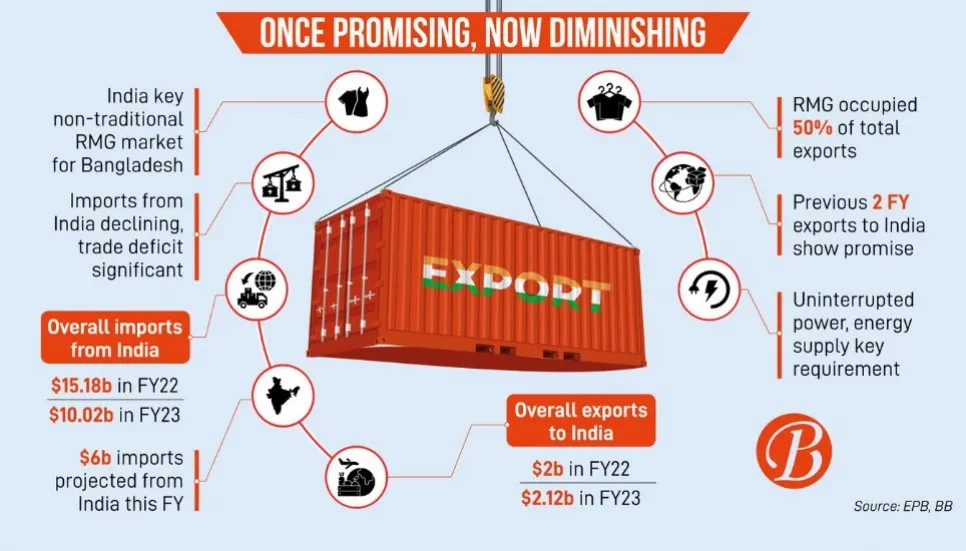
Bangladesh’s apparel export sector has encountered a significant setback in its trade with India, but it has been able to retain growth in other non-traditional markets.
According to the Export Promotion Bureau’s (EPB) country-wise export data, Bangladesh earned $728.85 million from India through clothing exports in the July-May period of FY24, which is 23.11 per cent lower compared to $947.86 million posted in the same period last FY.
Nipa Group, one of the major local clothing exporters to India, had exported around $40 million worth goods to the country in FY22, and FY23 volume was excellent as well. But the company exported clothing worth around $6 million to India in the 11 months of FY24.
“Indian buyers are not interested in importing from Bangladesh, and they offer prices lower than our production cost. There is no future in the Indian market,” said Nipa Group Managing Director Md Khosru Chowdhury.
Industry insiders said the Indian garment manufacturers are focusing on the local market from last year, and that is why local brands, who imported from Bangladesh, are now sourcing clothes from Indian apparel makers.
Besides, many brands also collect goods from Bangladesh’s stock lot traders, as those are cheaper.
Sparrow Group Managing Director Shovon Islam is doing business with Indian buyers, but he is yet to face any situation like Khosru.
He, however, said, “When the Indian government and manufacturers realised that it will be difficult for them to occupy the international market despite providing big facilities, they shifted to manufacturing for the local market.
“We know that India is one of the biggest consumer markets in the world, and their manufacturers consider their own markets as international. Besides, due to the global economic headwinds, Indian consumers' purchasing power also declined, and many brands declared bankruptcy.”
But those who are exporting to international brands, like me, are in a good position because these brands are doing well in India, he added.
In the previous FY, the country’s apparel sector touched a billion USD export milestone in the Indian market. However, due to the drastically negative export earnings growth, Bangladesh’s clothing export sector will likely fail to retain the billion USD export earnings in the market.
The EPB data shows that in the July-May period of FY24, woven product exports to India dropped by 19.72 per cent to $434 million, and knitwear item exports slipped by 27.61 per cent to $294 million year-on-year.
BGMEA Director Mohiuddin Rubel, however, blamed the global economic slowdown for the drastic earnings drop in the Indian market, and saying, “The eroding spending power of consumers and deceleration in their [Indian] import growth of fashion items is behind fall in our exports.”
It should be noted that Bangladesh’s overall import from India has been declining and FY24 imports will likely drop to $5.92 billion from $10.02 billion in FY23, according to the finance ministry projection.
Imports from India stood at $15.18 billion in FY22.
In the 11 months of this FY, the apparel sector earned $43.85 billion from the global market with a 2.86 per cent year-on-year growth.
During this period, the sector performed comparatively well in the non-traditional [which excludes USA, Canada, UK and European Union are considered non-traditional] markets, including India.
In the first 11 months of FY24, export earnings from the apparel sector rose by 6.47 per cent year-on-year to $8.19 billion.
Among the markets, apparel exports to Japan and Australia already stood at $1.48 billion and $1.19 billion, with 1.83 and 11.76 per cent year-on-year growth respectively.
Exporters pointed out that lead time is an issue, and Bangladesh failed to maintain a shorter lead time due to the ongoing severe energy shortage.
Khosru and Shovon said Indian manufacturers are collecting almost all raw materials from domestic sources, while Bangladeshi producers have to import.
For this reason, Bangladesh is already at least 15-20 days behind than the Indian clothing makers in terms of maintaining lead time.
“Under such circumstances, we have been facing 7-8 hours of load shedding daily, and as a result, we are failing to meet shipment deadlines. That is why many Indian buyers imported goods from Vietnam and China,” Shovon said.